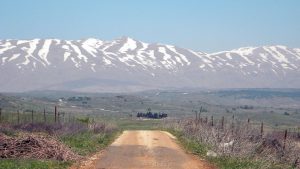
The gospel of Luke tells us that Jesus sent seventy disciples ahead of him into Galilee, essentially a declaration of victory over the gods of the nations—the seventy “sons of El” who met on the summit of the Canaanite Olympus, Mount Hermon.
As remarkable as it was, this event may have been an echo of a military campaign in the unseen realm led by Yahweh Himself:
O mountain of God, mountain of Bashan;
O many-peaked mountain, mountain of Bashan!
Why do you look with hatred, O many-peaked mountain,
at the mount that God desired for his abode,
yes, where the Lord will dwell forever?The chariots of God are twice ten thousand,
thousands upon thousands;
the Lord is among them; Sinai is now in the sanctuary.You ascended on high,
Psalm 68:15–18, ESV (emphasis added)
leading a host of captives in your train
and receiving gifts among men,
even among the rebellious, that the Lord God may dwell there.
The psalmist’s “many-peaked mountain” is Hermon, the southernmost peak in the Anti-Lebanon mountains. Now, because you’re sharp, you know that Mount Hermon is not the mountain of God. That’s Zion, in Jerusalem—the “mount that God desired for His abode.” However, the Hebrew phrase har elohim can be singular or plural, depending on the context. In this passage, considering the history of Mount Hermon, reading the verse “O mountain of the gods, mountain of Bashan” is a better fit.[1] At some point in history, Yahweh led His heavenly army against Hermon and returned to His abode with a host of captives.
What was that about? It’s hard to say. Scholars aren’t in agreement on the meaning of this psalm, but since Paul quoted it to describe Christ’s victory over the dark domain (Ephesians 4:8), we can assume that the psalmist likewise had some sort of battle in the spiritual war in mind.
It was not chance that Jesus began His last journey to Jerusalem right after descending from Mount Hermon. He’d picked a fight with the Fallen and it was time to complete the last phase of His mission. Notice that in the chapters of Matthew, Mark, and Luke describing the events that took place after the Transfiguration, it appears that Jesus took His time getting to Jerusalem, and He made the journey as public as possible.
Quick rabbit trail: Have you ever wondered why Jesus rode a donkey into Jerusalem? Yes, it was a fulfillment of prophecy:
Rejoice greatly, O daughter of Zion! Shout aloud, O daughter of Jerusalem! Behold, your king is coming to you; righteous and having salvation is he, humble and mounted on a donkey, on a colt, the foal of a donkey.
Zechariah 9:9, ESV
However, that doesn’t answer the question. Why did Zechariah prophesy a donkey colt for the Messiah? Was it to demonstrate the Savior’s humility? Maybe. It certainly fits the image of the suffering servant, a Messiah who washed the feet of His disciples to demonstrate that “the Son of Man came not to be served but to serve, and to give his life as a ransom for many.”[2]

From our modern perspective, we assume kings always rode horses, noble steeds worthy of their riders’ royal image. But this is another example of us reading our modern worldview backwards into the Bible. Imagining John Wayne, the Marlboro man, or a medieval knight in shining armor on a powerful stallion clouds our understanding of what was really going on. Jesus’ entry into Jerusalem on the back of a donkey was a clear message to the principalities and powers behind the people who had dominated the culture of the Near East since the time of the patriarchs, the Amorites.
You see, Amorite kings didn’t ride horses. In their world, the royal ride was a donkey. (The donkey was a powerful sacrificial animal, too. Donkey sacrifices were common among the Amorites.) In fact, around the time of Isaac and Jacob, an Amorite official in the kingdom of Mari, which was based on the Euphrates River near the modern border between Syria and Iraq, offered advice to his king, Zimri-Lim:
“May my lord honor his kingship. Since you are the king of Hanean (tribesmen), and also are the king of the Amorites, may my lord not ride horses; instead, he ought to ride a chariot or mules, so that he could honor his kingship.” Therefore, when Christ entered Jerusalem on a donkey, the population, as well as the authorities, knew how to read the symbolism at stake (Matthew 21).[3]
Of course, Jesus will return on a horse, but we’ll discuss that in an upcoming article. But just before His triumphant entry into Jerusalem, Jesus sent yet another message to the spirit realm.
We’ve already mentioned the story of Lazarus (John 11:1–44). He was the brother of Martha and Mary, the woman who anointed Jesus with ointment and wiped His feet with her hair. Oddly, when word reached Jesus of Lazarus’ illness, He didn’t seem bothered by the news. He stayed two days longer where He was before announcing to His disciples that it was time to return to Judea.
Jesus and His entourage arrived at Bethany to find Mary and Martha in mourning. Lazarus had already died; in fact, he’d been in the tomb for four days. This was deliberate. Jesus had waited until He knew Lazarus was dead before departing for Judea (John 11:14). It appears He had waited long enough so that there was no question in the minds of the mourners that Lazarus was truly dead before Jesus called him out of the tomb to the shock and awe of the crowd. As you can imagine, this attracted the attention of the authorities:
When the large crowd of the Jews learned that Jesus was at Bethany, they came, not only on account of him but also to see Lazarus, whom he had raised from the dead. So the chief priests made plans to put Lazarus to death as well, because on account of him many of the Jews were going away and believing in Jesus.
John 12:9–11, ESV
Do you get that? The chief priests were so desperate to keep their jobs that they not only wanted to kill Jesus, they planned to assassinate a man that God had raised from the dead!
There was a spiritual source behind their hubris. Jesus purposefully timed His arrival in Bethany to make it clear to all parties, human and spirit, that He’d literally revivified His friend. I think it was a message to a specific group of spirits.
Who were they, and why would they care? You’ve probably already guessed that I believe this was directed at the spirits of the Rephaim—the Nephilim, the sons of the Titans.
Correct. Here’s where I reveal some of the information from the Canaanite Rephaim texts that I held back earlier.
All three of the texts describe the spirits of these venerated dead as traveling to a ritual meal, something that appears similar to the kispum for the dead we described earlier. The meal is held in the house, sanctuary, plantations, or threshing-floor of the creator-god of the Canaanites, El, which was on Mount Hermon.[4] Pay special attention to the travel time of the Rephaim:
The [Rephaim] hurried to his sanctuary,[5]
to his sanctuary hurried the [elohim].The chariots they harnessed;
the horses they hitched, …
They mounted their chariots,
they came on their mounts.They journeyed a day
and a second.
After sunrise on the third
the [Rephaim] arrived at the threshing-floors,
the [elohim] at the plantations.[6] (Emphasis added)
The Amorite neighbors of the ancient Israelites summoned the spirits of the Rephaim to ritual meals in their honor on El’s mount of assembly, Mount Hermon. The travel required two full days, and they arrived after dawn on the third day.
No doubt you grasp the significance. But it’s even more interesting than that.
[1] Heiser, M. (2015), op. cit., p. 291.
[2] Matthew 20:28.
[3] Sasson, J. M. (1984). “Thoughts of Zimri-Lim,” Biblical Archaeologist, June 1984, pp. 118–119.
[4] Lipinski, op. cit., p. 69.
[5] In these translations by respected Ugaritic scholar Nicolas Wyatt, I have substituted “Rephaim” (Ugaritic rpum) for Wyatt’s choice, “saviours,” and “elohim” (Ugaritic ilnym) for Wyatt’s preferred word, “divinities.”
[6] KTU 1.20:ii:2–7. Wyatt, N. (2002). Religious Texts from Ugarit, 2nd ed. (London; New York: Sheffield Academic Press), pp. 316–317.
[7] KTU 1.21:ii:1-7. Ibid., p. 319.

1 Comment